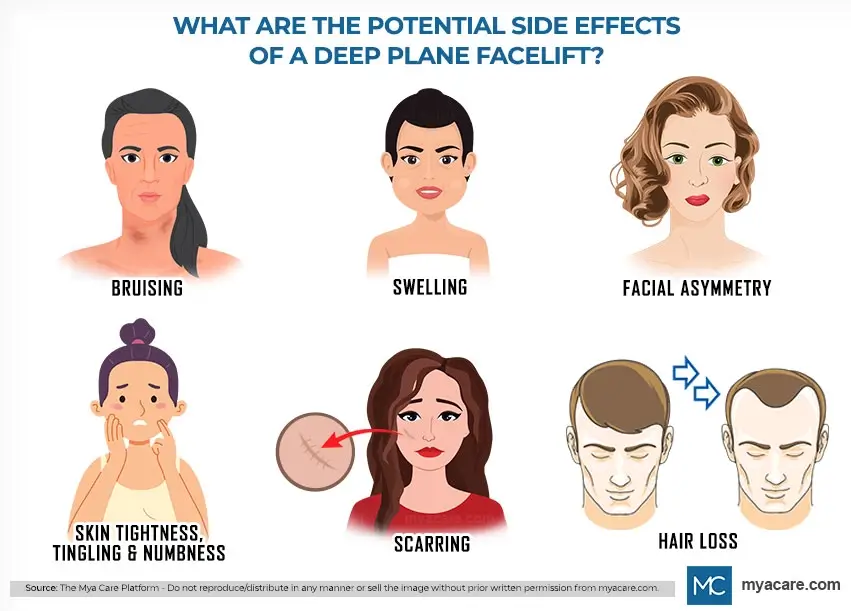Everything You Need to Know About Deep Plane Facelift

In the past decades, we are witnessing a growing demand for cosmetic procedures. In the beginning, these were almost all surgical. In recent years, however, minimally invasive aesthetic treatments, such as Botulinum toxin injections and dermal fillers, are gaining popularity.
While both types have their advantages and drawbacks, it is clear that only surgery can deliver radical and long-lasting results. Facelift surgery is particularly effective, and its latest version, the Deep Plane Facelift, is even more so.
Overview
Facelift surgery is the best way to achieve radical improvements in the lower two-thirds of the face. The procedure can effectively smooth out the wrinkles and tighten the skin in the jawline and neck area.
When done well, a facelift can erase a decade from a patient's face. This is why it has become the gold standard in cosmetic surgery.
But, there is a downside too. Facelift surgery can sometimes produce unnaturally looking results. A well-known “plastic look” is what most people hope to avoid.
That’s something a Deep Plane Facelift (DPF) can help with. It is an advanced facelift technique that produces substantial, natural-looking, and long-lasting results. If you want to know more, this article is for you.
What is a Deep Plane Facelift?
A DPF is a type of facelift surgery that targets deeper tissue layers for a more radical improvement of facial aesthetics. The ability to loosen or tighten deep-lying facial muscles and ligaments maximizes the facelift effect.
The technique allows surgeons to perform a meticulous lift without tightly pulling the superficial tissues. Therefore, the results are more natural-looking and longer-lasting.
It is also possible to reposition fat pads inside the cheeks with DPF. That enables a type of "lift" in the mid-face area that only a deep plane facelift can achieve.
A DPF goes further and lasts longer than a traditional facelift. It is much better in helping specific issues, such as nasolabial folds. That is a valuable advantage in the race for a more youthful appearance.
However, all good things have a downside too. A deep plane facelift is highly invasive. So, there is a higher risk of complications, and the recovery process is longer.
The Effects
Like the other types of facelift surgery, a DPF primarily targets facial skin laxity and all the aesthetic issues that stem from it.
The procedure drastically improves the appearance of the face, jawline, and neck, especially in healthy older patients with significant skin laxity issues.
Most people find the deep plane facelift before and after photos unbelievable because the improvements are radical but look natural.
That’s why the best way to describe the effects of DPF is to compare them with traditional facelift techniques, such as Superficial Musculo-Aponeurotic System or SMAS.
For example, SMAS only treats the lower third of the face and the jawline. Unlike DPF, it cannot address nasolabial folds and droopy cheeks.
That's why some surgeons combine SMAS with fat transfer to the cheeks. Unfortunately, that does not fix the droopiness. It only makes the cheeks look puffy and unnatural.
Additionally, SMAS facelift pulls and separates the skin from deeper muscles, while DPF repositions the underlying tissues without touching the skin.
These are crucial advantages. They contribute to higher quality aesthetic outcomes and overall longer-lasting effects.
What are the potential side effects?

The potential side effects of DPF surgery may include:
- Tightness of the skin,
- Tingling sensation,
- Numbness,
- Bruising,
- Swelling,
- Scarring,
- Facial asymmetry, and
- Hair loss
There is also a low risk of severe complications, such as:
- Infection,
- Prolonged edema,
- Facial nerve injury, and
- Tissue necrosis
The Recovery
The initial recovery phase after a deep plane facelift lasts up to three weeks. Patients wear a drain, compression garment, and neck support for at least two weeks.
During this time, bruising, swelling, and discomfort are common occurrences. Going back to work or exercising is not recommended.
Frequently Asked Questions
Here are the answers to some usual questions people ask online about a deep plane facelift.
Is a deep plane facelift better?
It is difficult to say that one surgical option is better than the other in terms of the quality of outcomes. After all, many factors influence this. However, a DPF is the best treatment for those looking to get dramatic improvements and long-lasting results.
Does a deep plane facelift last longer?
A DPF is a radical procedure. It is significantly more invasive than a SMAS facelift and affects deeper structures. On average, the results also last longer, up to fifteen years in some cases.
Does a deep plane facelift address the neck?
The straightforward answer is yes. Repositioning facial deep tissues also indirectly improves the appearance of the jawline and neck.
How painful is a deep plane facelift?
Surgical procedures are invasive. They involve incisions, bleeding, stitching, and various risks of complications. All of these can cause discomfort and pain. Cosmetic surgery is no exception. However, most DPF patients only report pain on the day of surgery and the next day. Luckily, it's nothing that medications can't help.
Deep Plane Facelift Cost
It takes an experienced, board-certified surgeon and a team of qualified medical workers in a safe clinical setting to perform a successful DPF surgery with minimal risk of complications. Something like that cannot come at a low price, and DPF is the most expensive type of facelift surgery.
However, the cost of a deep plane facelift varies significantly worldwide. In the United States, for example, a DPF procedure costs between twenty to thirty thousand US dollars. The same procedure in Turkey costs between three and ten thousand, while in Thailand, it is between two and five thousand US dollars.
The Bottom Line
A deep plane facelift is the most invasive type of facial cosmetic surgery. Consequently, the recovery process is the longest. However, the rejuvenating effects are unmatched by any other aesthetic intervention. They cause dramatic improvements and last ten to fifteen years.
To search for the best Plastic & Cosmetic Surgery healthcare providers in Croatia, Germany, Greece, India, Malaysia, Singapore, Slovakia, Spain, Thailand, Turkey, Ukraine, the UAE, the UK and the USA, please use the Mya Care search engine.

Dr. Rosmy Barrios is an aesthetic medicine specialist with international work experience. She earned her physician diploma at the Universidad Del Norte’s School of Medicine in Barranquilla, Colombia, and her specialty at John F. Kennedy University in Buenos Aires, Argentina. Dr. Barrios is a member of the Pan-American Aesthetic Medicine Association (PASAM) and the Union Internationale de Médecine Esthétique (UIME). She is an expert health writer with keen interests in aesthetic medicine, regenerative aesthetics, anti-aging, fitness, and nutrition. Currently, Dr. Barrios heads the Regenerative Aesthetics department at a renowned Internal Medicine clinic based in Belgrade, Serbia.
References:
Featured Blogs



